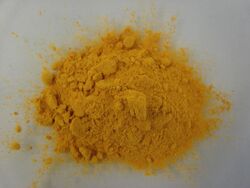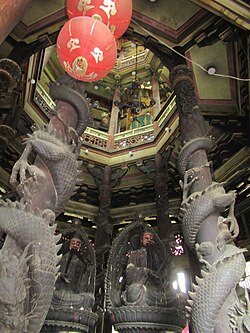Gamboge
| Gamboge | |
|---|---|
 | |
| Hex triplet | #E49B0F |
| Source | Maerz and Paul[lower-alpha 1] |
| ISCC–NBS descriptor | Strong orange yellow |
History
Gamboge’s first recorded use dates back to the 8th century during which time it appeared in Japanese art.[1](p170) Some historians speculate small shipments of the pigment were able to be distributed in European contexts due to the occasional over-land trade journeys made from Asia to Europe. Gamboge would become much more accessible beginning in the 17th century as shipping grew in popularity as a method of transporting goods from Asia to Europe.[2] It was around this time that Gamboge’s popularity in watercolors grew tremendously.[citation needed]
The pigment is derived from the gum of a species of evergreen of the family Guttiferae which grows in southeast Asia, primarily Cambodia and Thailand.[3](p149) In fact, Gamboge gets its name from a now-antiquated name for Cambodia, Camboja, though it was also referred to as gama gitta in some 17th century European color manuals.[2](p106) The pigment is extracted from Guttiferae trees through a process of cutting several deep incisions into the tree’s trunk thus allowing the resin to bleed out into pre-mounted bamboo canes used as receptacle to initially catch and later transport the product.[1] The practice of collecting Gamboge in bamboo cane was so widespread and recognizable that the pigment was often referred to as “pipe Gamboge” for how it conformed to the cylindrical shape of the receptacle.[1](p170)
There was a brief shortage of the pigment during the 1970s and 1980s due to trade restrictions placed on the Khmer Rouge regime.[4](pp220–221) It was during this time that shipments of the gum which makes Gamboge were found to contain bullet casings and other impurities which tainted the pigment.[4](pp220–221)
While Gamboge is best known for its use in artwork, it does have a secondary function as a laxative. In small doses it can cause watery feces while large doses have been reported to cause death.[4]
Production
Gamboge is most often extracted by tapping latex (sometimes incorrectly referred to as sap) from various species of evergreen trees of the family Clusiaceae (also known as Guttiferae). The tree most commonly used is the gamboge tree (genus Garcinia), including G. hanburyi (Cambodia and Thailand), G. morella (India and Sri Lanka), and G. elliptica and G. heterandra (Myanmar).[1](p170) The orange fruit of Garcinia gummi-gutta (formerly called G. cambogia) is also known as gamboge or gambooge.[5]
The trees must be at least ten years old before they are tapped.[6] The resin is extracted by making spiral incisions in the bark, and by breaking off leaves and shoots and letting the milky yellow resinous gum drip out. The resulting latex is collected in hollow bamboo canes.[7] After the resin is congealed, the bamboo is broken away and large rods of raw gamboge remain.[8]
Visual characteristics
Once extracted from the trees in which it is found, Gamboge resin has a brownish-yellow color.[3](p143) Once ground, the resin takes on a deep yellow color.[3] Artists sometimes combined Prussian blue with gamboge to create green; they also mixed it with burnt sienna to make orange.[1](p170)
Gamboge was most commonly used in watercolor painting.[3](p145)
Permanence
Gamboge is highly sensitive to light.[3](p145) It is known to react poorly with lime surfaces and, as such, is deemed unsuitable for frescos.[1] Gamboge is also known to react with white lead.[1]
Notable occurrences
Gamboge has not been extensively identified in works of art from any time period; many analyses of paintings simply identify the presence of "organic yellow" without distinguishing between different organic yellow pigments.[3](pp152–153)
Gamboge has been identified as the underlying gold paint in the Maitepnimit Temple in Thailand as well as having featured in the Medieval Armenian Glajor Gospel.[1] Though not authenticated, it has also been noted that Rembrandt may have used the pigment in a few of his works and that it appears in J. M. W. Turner's color box.[3](p153)
Etymology
The word gamboge comes from gambogium, the Latin word for the pigment, which derives from Gambogia, the Latin word for Cambodia.[9] Its first recorded use as a colour name in English was in 1634.[10]
Notes
- ↑ The colour displayed in the colour box above matches the colour called gamboge in the 1930 book by Maerz and Paul (1930) A Dictionary of Color New York: McGraw-Hill; the colour gamboge is displayed on page 43, Plate 10, Color Sample K6.
References
- ↑ 1.0 1.1 1.2 1.3 1.4 1.5 1.6 1.7 Cite error: Invalid
<ref>tag; no text was provided for refs named:2 - ↑ 2.0 2.1 Cite error: Invalid
<ref>tag; no text was provided for refs named:1 - ↑ 3.0 3.1 3.2 3.3 3.4 3.5 3.6 Cite error: Invalid
<ref>tag; no text was provided for refs named:0 - ↑ 4.0 4.1 4.2 Finlay, Victoria (2002). Color : a natural history of the palette. New York: Ballantine Books. ISBN 0-345-44430-2. OCLC 51302192.
- ↑ "Gamboge: Garcinia cambogia". Asia Food. http://asiasociety.org/lifestyle/food-recipes?wordid=2651.
- ↑ Grieve, Maud; Leyel, C. F. (1971). A Modern Herbal (illustrated ed.). Courier Dover Publications. p. 341. ISBN 0-486-22798-7. https://books.google.com/books?id=tLWve-VvBLoC. Retrieved 2009-03-03.
- ↑ Nicholas Eastaugh; Valentine Walsh; Tracey Chaplin; Ruth Siddall (2004). The Pigment Compendium: A Dictionary of Historical Pigments. Butterworth-Heinemann. ISBN 0-7506-5749-9. https://books.google.com/books?id=TKFiYsc_xOAC&q=%22Garcinia+hanburyi%22+gambogia&pg=PA164.
- ↑ St. Clair, Kassia (2016). The Secret Lives of Colour. London: John Murray. p. 81. ISBN 9781473630819. OCLC 936144129.
- ↑ Mish, Frederic C., ed (1984). Webster's Ninth New Collegiate Dictionary. Springfield, Massachusetts: Merriam-Webster. p. 504.
- ↑ Maerz and Paul (1930). "Color Sample of Gamboge: Page 43 Plate 10 Color Sample K6". A Dictionary of Color. New York: McGraw Hill. p. 195.
External links
 |



